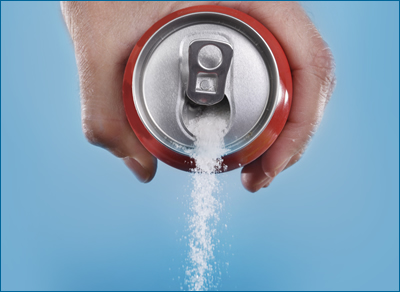How to Cut Your Sugar Intake

Trying to eat less sugar is difficult, and not just because we like it so much. Sure, it’s hard to give up something that tastes so good, but what really makes eating less sugar so tough is the fact that it’s nearly impossible to avoid it.
Sugar in Foods – the Sugar You Don’t See
Unless you are a fanatic about reading ingredients labels, there’s a good chance that you’re eating sugar you didn’t even know about and in places where you wouldn’t expect to find it. I’ll bet you didn’t think a serving of pasta sauce could contain nearly 5 teaspoons of sugar, or that 80% of the calories in ketchup come from sugar. Once you start looking at ingredients lists, you’ll find sugar in everything from soups to salad dressings.
5 Tips for Cutting Your Sugar Intake
Read Nutrition Labels.
This is really the first step in reducing your sugar intake for a couple reasons. Sugar comes in many forms, so you’ll want to read your ingredients list carefully for words other than just “sugar.” Sucrose, glucose, dextrose, lactose, maltose, brown rice syrup, fruit juice concentrate, maltodextrin, corn syrup, molasses are just some of the many forms of sugar added to foods. On the flip side, be aware of those sugars that naturally occur in foods. The lactose in milk and the fructose in fruit, for example, will show up on the nutrition facts panel as “sugar” even though no sugar is added. The nutrition facts panel on a package of frozen, unsweetened strawberries might list 10 grams of sugar per serving, but that’s just the natural fructose in the fruit. Check the ingredients list to be sure, which in this case should just say, “strawberries.”
Sweeten foods yourself.
Many foods that come pre-sweetened, like cereals, yoghurt, salad dressings or ‘alternative’ milks (rice, hemp, soy, etc.), have surprising amounts of sugar. Vanilla flavored rice, hemp or soy milks can have more than 3 teaspoons of added sugar in a 240ml cup. Some varieties of instant oatmeal have more than a tablespoon of added sugar, which comes in a very tiny packet - and who eats just one? Some single-serve yoghurts pack 30 grams (7 ½ teaspoons) of sugar. Even if you add your own sugar to these foods, you can certainly get by with less. To cut sugar even further, try sweetening cereal with a sliced banana or a handful of berries. And here’s another trick: try dropping a whole date or a few raisins and a few drops of vanilla extract into your carton of unsweetened milk alternative. It adds lots of flavor with just a trace of sugar.
Enjoy naturally sweet flavors.
Your taste buds may be so over-saturated with sugar that you’ve lost your appreciation for foods that are naturally sweet. Fruits are an obvious substitute for sugary desserts. But sweet spices like cinnamon, nutmeg or clove can add sweet notes to fruits, cereals or yogurt in place of sugar.
Cut back on liquid sugar.
It’s an obvious suggestion, I know. But when you consider that half the population consumes a sugary drink on any given day, or that 25% of adults take in 200 calories a day from sugary beverages, it’s a suggestion worth repeating. Curb your intake of soft drinks, sweetened coffee and tea drinks, and fruity drinks like lemonade. Instead, try flavorful teas, or add some citrus peel or a slice of fruit to your water for a calorie-free beverage.

